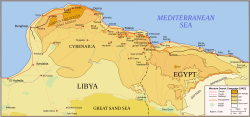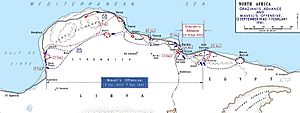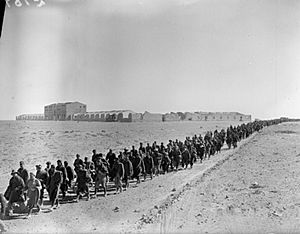Battle of Sidi Barrani facts for kids
Quick facts for kids Battle of Sidi Barrani |
|||||||
|---|---|---|---|---|---|---|---|
| Part of Operation Compass, during the Second World War | |||||||
 Western Desert |
|||||||
|
|||||||
| Belligerents | |||||||
|
|
|||||||
| Commanders and leaders | |||||||
|
|||||||
| Strength | |||||||
| 36,000 men 120 guns 275 tanks 142 aircraft |
60,000 men 250 guns 120 tanks 331 aircraft |
||||||
| Casualties and losses | |||||||
| 624 | 2,194 killed 2,286 wounded 38,300 prisoners 237 guns 73 tanks c. 1,000 vehicles |
||||||
The Battle of Sidi Barrani was a major battle during World War II. It took place from December 10 to 11, 1940. This battle was the start of Operation Compass, which was the first big attack by British forces in the Western Desert Campaign.
Sidi Barrani is a town on the coast of Egypt. It had been taken over by the Italian 10th Army in September 1940. British, Commonwealth, and other Allied troops attacked the town and successfully took it back.
As the Italian 10th Army retreated from Sidi Barrani, their troops were crowded on the coast road. British warships like HMS Terror fired on them. This bombardment lasted all day and night on December 11. By December 12, the only Italian forces left in Egypt were near Sollum and Sidi Omar.
The British captured about 38,300 Italian soldiers. They lost only 624 of their own men. This victory allowed the British to continue their attack on Italian positions in Egypt. They eventually captured Cyrenaica (a region in Libya) and most of the 10th Army.
Contents
Why the Battle Happened
Control of North Africa
Cyrenaica is a region in eastern Libya. It had been an Italian colony since 1912. Italy wanted to protect its borders with Tunisia (a French colony) to the west and Egypt to the east. They set up a main military command in North Africa.
Italy had two main armies there: the 5th Army and the 10th Army. These armies had many soldiers, including Italian and Libyan troops. Italian soldiers were thought to have high morale. The Italian Navy had good ships, but lacked experience. The Italian Air Force was not considered very strong.
British Forces in Egypt
The British had military forces in Egypt since 1882. However, their numbers were smaller due to a treaty signed in 1936. These forces protected the Suez Canal and the Red Sea route. These routes were very important for Britain to communicate with its territories in Asia.
In 1939, Archibald Wavell became the main commander of British forces in the Middle East. At the start of the war, Britain had about 36,000 troops in Egypt. They also had 27,500 men training in Palestine.
The British forces included the 7th Armoured Division. This was one of Britain's main tank training groups. In June 1940, the 6th Infantry Division took command in the Western Desert. Their job was to push back Italian forces from their border posts. The 7th Armoured Division moved to Mersa Matruh to help protect the border.
Supplying the Armies
Supplying armies in the desert was very difficult for both sides. The main Italian supply route to Tripoli in Libya was by sea. Ships had to travel around Sicily and along the Libyan coast. This was a long journey, and British ships and planes from Malta could attack them. Once supplies reached Tripoli, they had to be moved long distances by road. The main coastal road, called the Via Balbia, was about 650 miles (1,046 km) to Benghazi. This road could flood and was open to air attacks.
The British also faced supply challenges. Their main base was at Mersa Matruh, about 200 miles (322 km) west of Alexandria. Water was a big problem in the desert. Wells often had salty water. Fresh water came from old Roman aqueducts or was brought by boats from Alexandria. Vehicles were also in short supply. The desert quickly wore out tanks and trucks.
The Desert Terrain
The fighting took place in the Western Desert. This area was about 240 miles (386 km) wide. It stretched from Mersa Matruh in Egypt to Gazala on the Libyan coast. The only paved road was the Via Balbia.
The desert was mostly flat and stony. It was home to scorpions, snakes, and flies. Only a few Bedouin nomads lived there. They knew the tracks that linked the few water wells. Navigating the desert was hard. Soldiers relied on the sun, stars, and compasses. Sometimes, Italian troops got lost.
The weather was extreme. Days were very hot, and nights were very cold. A hot desert wind called the Sirocco (or Ghibli) would blow. It created clouds of fine sand, making it hard to see. This sand also got into eyes, lungs, and machinery. Vehicles and aircraft needed special filters.
Leading Up to the Battle
Border Fights
On June 11, 1940, the war officially began. British forces immediately crossed into Libya. They fought with Italian troops at Sidi Omar. Some Italian soldiers didn't even know war had been declared. The British captured Fort Capuzzo and Fort Maddalena, taking 220 prisoners.
The British continued to patrol the border. They showed that they were stronger than the Italian 10th Army in this area. However, the desert conditions were tough on vehicles. Tanks wore out quickly, and spare parts were hard to find.
Italian Invasion of Egypt
On September 13, 1940, Italy began its invasion of Egypt. This was called Operazione E. The Italian army moved towards Matruh. They captured Musiad, Sollum, and the airfield. British forces slowly pulled back, harassing the Italian advance.
The Italians stopped their advance at Sidi Barrani. They dug in and built fortified camps. These camps were about 80 miles (129 km) west of the main British defenses at Matruh. The Italians started building a water pipeline to bring supplies forward.
The British continued to watch the Italian forces. They also prepared for their own attack. They decided to launch a surprise attack on the Italian camps.
The British Plan

General Wavell ordered a plan to push the Italians back. He noticed that the Italian camps were too far apart to support each other. The plan, called Operation Compass, was meant to be a quick five-day attack. However, they were ready to continue if it went well.
The plan involved the 7th Armoured Division and the 4th Indian Division. They would sneak through a gap between Italian camps. One Indian brigade and Infantry tanks (heavy tanks) would attack the Nibeiwa camp from the west. The 7th Armoured Division would protect their side. After Nibeiwa, they would attack other camps.
British warships would also fire on Italian positions along the coast. The preparations for this attack were kept very secret. Soldiers practiced near Matruh, but they didn't know the practice area was a copy of the real Italian camps. Many didn't know the operation was real until December 7.
To help the attack, British planes bombed Italian airfields. They destroyed many Italian aircraft. On December 9, a special force called Selby Force moved from Matruh. Their job was to cut off the Italian camp at Maktila. British warships also bombarded Maktila and Sidi Barrani.
Italian Defenses
In December 1940, the Italian 10th Army in Egypt had about 40,000 men around Sidi Barrani. They had built fortified camps spread out over 50 miles (80 km). These camps were defended by different Italian divisions.
The Italian forces in Egypt had about 80,000 men, 250 guns, and 120 tanks. The British thought the Italian air force had many bombers and fighters. However, the actual numbers were lower. Many Italian planes were far to the west.
The Battle Begins
Taking Sidi Barrani
Selby Force guarded the eastern side of Sidi Barrani. The rest of the British forces attacked the Italian camps further inland. On December 10, the 4th Armoured Brigade moved north. They cut the main coast road between Sidi Barrani and Buq Buq.
News that the Nibeiwa camp had fallen reached Selby Force. They sent troops to block the western exits from Maktila. However, the ground was difficult, and it was dark. The Italian 1st Libyan Division managed to escape.
The 16th Infantry Brigade was sent to cut off the roads into Sidi Barrani. Sidi Barrani was defended by two Italian divisions. They had eight strongpoints, each with a battalion of soldiers. But the defense line was too long to be effective.
The attack on December 10 was confusing. It was very cold, and a dust storm made it hard to see. The 16th Brigade attacked at 6:00 a.m. They were pushed back by Italian artillery. Three hours later, with more artillery and Matilda tanks, they attacked again. British planes and navy ships also helped.
The fighting continued all morning. At 1:30 p.m., Italian Blackshirt soldiers holding two strongholds suddenly surrendered. Soon after, the brigade cut the roads south and west of Sidi Barrani. The British attacked again just after 4:00 p.m. Matilda tanks drove into the Italian defenses. Italian artillery shells could not stop the Matilda tanks. The Italian gunners fought with rifles and grenades but were defeated.
By 6:00 p.m., most of the western and southern parts of Sidi Barrani were captured. Only a small area east of the harbor was still fighting. About 2,000 Blackshirt soldiers surrendered instead of counter-attacking.
Selby Force's Role
More British troops arrived from the captured camps. They advanced through the port. This trapped the remaining Italian forces against Selby Force. The Italian 1st Libyan Division, 2nd Libyan Division, and 4th CC.NN. Division "3 Gennaio" were caught.
Selby Force had chased the retreating Italian 1st Libyan Division. They pushed part of the Italian column into sand dunes. British tanks arrived and defeated the Italians in the dunes. The Italian defenders were trapped in a small area against the sea.
When the British attacked again on December 11, many Italians surrendered. However, about 2,000 troops from the 2nd Libyan Division held out until the afternoon.
What Happened Next
Battle Results
From December 9 to 11, the British took 38,300 Italian prisoners. They also captured 237 guns, 73 tanks, and about 1,000 vehicles. The British had only 624 casualties. The Italian forces lost 2,194 men killed and 2,286 wounded.
Continuing the Fight
On December 11, the 7th Armoured Brigade was ordered to help clear the area. They captured many men and guns. Italian forces had pulled back from other camps overnight. An order to cut them off arrived too late. The Italians retreated towards Halfaya.
The British tried to chase the Italians. However, they had big supply problems. They had captured twenty times more prisoners than they expected, which made it hard to move forward.
As the Italians retreated, British warships continued to bombard them. By December 12, the only Italian positions left in Egypt were near Sollum and Sidi Omar. By December 15, Sollum and the Halfaya Pass were captured. The British continued their advance west towards Bardia.
See also
- List of British military equipment of World War II
- List of Australian military equipment of World War II
- List of Italian military equipment in World War II
Images for kids
-
Bristol Bombay, before delivery to 216 Squadron (CH2936)













